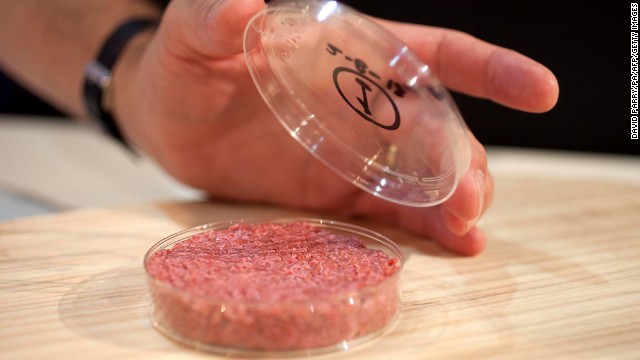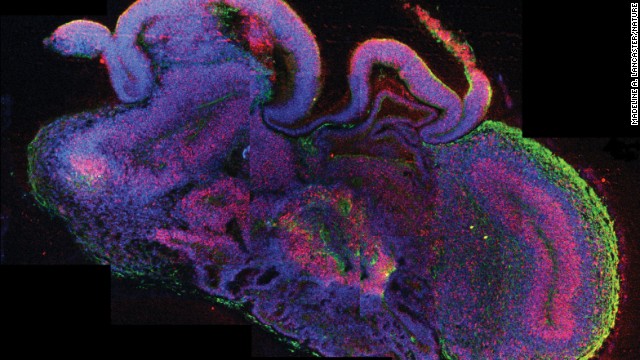 In October 2014, a study showed that stem cells could help people with macular degeneration, an eye disease that causes progressive loss of sight. Researchers followed 18 patients for three years and saw no signs of rejected of the transplanted stem cells. Click through the gallery to learn more about stem cell research.
In October 2014, a study showed that stem cells could help people with macular degeneration, an eye disease that causes progressive loss of sight. Researchers followed 18 patients for three years and saw no signs of rejected of the transplanted stem cells. Click through the gallery to learn more about stem cell research.  In January 2014, researchers announced they had developed a new method of making stem cells: by placing skin cells in an acidic environment. But the researchers retracted their papers in July, citing "several critical errors" in their study data.
In January 2014, researchers announced they had developed a new method of making stem cells: by placing skin cells in an acidic environment. But the researchers retracted their papers in July, citing "several critical errors" in their study data.  Stem cells have the potential to become many kinds of cells and can renew themselves through cell division. Scientists view stem cells as a possible gateway to curing many medical conditions, from Parkinson's disease to diabetes. Stem cells are viewed on computer here at UConn Health Center in 2010.
Stem cells have the potential to become many kinds of cells and can renew themselves through cell division. Scientists view stem cells as a possible gateway to curing many medical conditions, from Parkinson's disease to diabetes. Stem cells are viewed on computer here at UConn Health Center in 2010.  A closeup of a microscope slide taken in 2000 at the Reproductive Genetics Institute's Chicago laboratory shows transplanted stem cells taken from the umbilical cord blood of a baby named Adam Nash. Adam's sister Molly has a genetic disease called Fanconi anemia. Their parents wanted to have a child who could be a stem cell donor for Molly. Using in vitro fertilization, doctors created embryos and then tested them for the genetic disease. They chose one that did not have the disorder, which grew into baby Adam. Molly received a stem cell transplant from stem cells from Adam's umbilical cord. Both children are alive today.
A closeup of a microscope slide taken in 2000 at the Reproductive Genetics Institute's Chicago laboratory shows transplanted stem cells taken from the umbilical cord blood of a baby named Adam Nash. Adam's sister Molly has a genetic disease called Fanconi anemia. Their parents wanted to have a child who could be a stem cell donor for Molly. Using in vitro fertilization, doctors created embryos and then tested them for the genetic disease. They chose one that did not have the disorder, which grew into baby Adam. Molly received a stem cell transplant from stem cells from Adam's umbilical cord. Both children are alive today.  In 1998, President Bill Clinton requested a National Bioethics Advisory Commission to study the question of stem cell research.
In 1998, President Bill Clinton requested a National Bioethics Advisory Commission to study the question of stem cell research.  In 2000, the National Institutes of Health issued guidelines for the use of embryonic stem cells in research, specifying that scientists receiving federal funds could use only extra embryos that would otherwise be discarded. President Clinton approved federal funding for stem cell research, but Congress did not fund it. Above, a Cell Expansion System, which is used to grow cells, is seen during the 2010 World Stem Cell Summit in Detroit.
In 2000, the National Institutes of Health issued guidelines for the use of embryonic stem cells in research, specifying that scientists receiving federal funds could use only extra embryos that would otherwise be discarded. President Clinton approved federal funding for stem cell research, but Congress did not fund it. Above, a Cell Expansion System, which is used to grow cells, is seen during the 2010 World Stem Cell Summit in Detroit.  In August 2001, President George W. Bush announced that he would allow federal funding for about 60 existing stem cell lines created before this date. Above, a human stem cell colony, which is no more than 1 millimeter wide and comprises thousands of individual stem cells, grows on mouse embryonic fibroblast in a research laboratory in September 2001.
In August 2001, President George W. Bush announced that he would allow federal funding for about 60 existing stem cell lines created before this date. Above, a human stem cell colony, which is no more than 1 millimeter wide and comprises thousands of individual stem cells, grows on mouse embryonic fibroblast in a research laboratory in September 2001.  In 2005, Connecticut and Illinois designated state funds to support stem cell research in their states. Above, a woman works on stem cells at the University of Connecticut's Stem Cell Institute at the UConn Health Center in August 2010 in Farmington.
In 2005, Connecticut and Illinois designated state funds to support stem cell research in their states. Above, a woman works on stem cells at the University of Connecticut's Stem Cell Institute at the UConn Health Center in August 2010 in Farmington.  In March 2009, President Barack Obama signed an executive order that removed restrictions on embryonic stem cell research. His action overturned an order approved by President George W. Bush in August 2001 that barred the National Institutes of Health from funding research on embryonic stem cells beyond using 60 cell lines that existed at that time.
In March 2009, President Barack Obama signed an executive order that removed restrictions on embryonic stem cell research. His action overturned an order approved by President George W. Bush in August 2001 that barred the National Institutes of Health from funding research on embryonic stem cells beyond using 60 cell lines that existed at that time.  In November 2010, William Caldwell, CEO of Advanced Cell Technology, said the FDA had granted approval for his company to start a clinical trial using cells grown from human embryonic stem cells. The treatment would be for an inherited degenerative eye disease. Above, dozens of packages containing frozen embryonic stem cells remain in liquid nitrogen in a laboratory at the University of Sao Paulo's human genome research center in Sao Paulo, Brazil, in March 2008.
In November 2010, William Caldwell, CEO of Advanced Cell Technology, said the FDA had granted approval for his company to start a clinical trial using cells grown from human embryonic stem cells. The treatment would be for an inherited degenerative eye disease. Above, dozens of packages containing frozen embryonic stem cells remain in liquid nitrogen in a laboratory at the University of Sao Paulo's human genome research center in Sao Paulo, Brazil, in March 2008.  In May 2011, stem cell therapy in sports medicine was spotlighted after New York Yankees pitcher Bartolo Colon was revealed to have had fat and bone marrow stem cells injected into his injured elbow and shoulder while in the Dominican Republic.
In May 2011, stem cell therapy in sports medicine was spotlighted after New York Yankees pitcher Bartolo Colon was revealed to have had fat and bone marrow stem cells injected into his injured elbow and shoulder while in the Dominican Republic.  In February 2012, early research published by scientists at Cedars-Sinai Medical Center and Johns Hopkins University showed that a patient's own stem cells can be used to regenerate heart tissue and help undo damage caused by a heart attack. It is the first instance of therapeutic regeneration. Above, fluid is removed from the knee of a patient to collect adult stem cells by at a clinic in Broomfield, Colorado.
In February 2012, early research published by scientists at Cedars-Sinai Medical Center and Johns Hopkins University showed that a patient's own stem cells can be used to regenerate heart tissue and help undo damage caused by a heart attack. It is the first instance of therapeutic regeneration. Above, fluid is removed from the knee of a patient to collect adult stem cells by at a clinic in Broomfield, Colorado.  In October 2012, Sir John Gurdon and Shinya Yamanaka were awarded the Nobel Prize for Physiology or Medicine for discovering how to make pluripotent stem cells. They both showed that cells could be reprogrammed after they had specialized. This changed scientists' understanding of how cells and organisms develop.
In October 2012, Sir John Gurdon and Shinya Yamanaka were awarded the Nobel Prize for Physiology or Medicine for discovering how to make pluripotent stem cells. They both showed that cells could be reprogrammed after they had specialized. This changed scientists' understanding of how cells and organisms develop.  On May 16, 2013, scientists announced that they had, for the first time, produced embryos using skin cells and then used the embryos to make stem cell lines. This technique resembles what was used in cloning Dolly the sheep, but the earlier technique could not have led to a fully-cloned human baby. A photo provided by the Oregon Health & Science University shows a stem cell colony produced from human skin cells.
On May 16, 2013, scientists announced that they had, for the first time, produced embryos using skin cells and then used the embryos to make stem cell lines. This technique resembles what was used in cloning Dolly the sheep, but the earlier technique could not have led to a fully-cloned human baby. A photo provided by the Oregon Health & Science University shows a stem cell colony produced from human skin cells.  On August 5, 2013, the world's first stem cell burger was cooked and eaten in London. The brainchild of Maastricht University's Mark Post, the burger was made of 20,000 small strands of meat grown from a cow's muscle cells, took three months to create and cost $330,000 to develop.
On August 5, 2013, the world's first stem cell burger was cooked and eaten in London. The brainchild of Maastricht University's Mark Post, the burger was made of 20,000 small strands of meat grown from a cow's muscle cells, took three months to create and cost $330,000 to develop.  In September 2013, scientists announced they had created what they are calling "cerebral organoids" using stem cells. These pea-sized structures are made of human brain tissue, and they can help researchers explore important questions about brain development and disorders that occur during these first stages of life.
In September 2013, scientists announced they had created what they are calling "cerebral organoids" using stem cells. These pea-sized structures are made of human brain tissue, and they can help researchers explore important questions about brain development and disorders that occur during these first stages of life.
- Stem cells were transplanted into 18 patients with macular degeneration
- Nearly blind patients' sight improved about three lines on standard eye chart
- Scientists saw no signs of rejection in three-year followup
(CNN) -- Researchers say that human embryonic stem cells have restored the sight of several nearly blind patients -- and that their latest study shows the cells are safe to use long-term.
According to a report published this week in The Lancet, the researchers transplanted stem cells into 18 patients with severe vision loss as a result of two types of macular degeneration, an eye disease that causes progressive loss of sight.
Nine had Stargardt macular degeneration, the leading cause of juvenile blindness, and nine had dry atrophic age-related macular degeneration, the most common cause of vision loss in people over 50. There are currently no approved treatments for either condition.
The Mayo Clinic defines macular degeneration as occurring when tissue in your macula, a spot in the center of your retina, thins and breaks down. Stem cells can help rebuild this tissue.
All 18 of the study's patients were followed for three years. Researchers saw no signs of rejection of the cells and no abnormal growth, tumor formation or unwanted tissue types in any of the patients during that time period. On average, the vision of the patients improved about three lines on the standard eye chart.
Patients in a control group who did not receive a stem cell transplant did not show similar sight improvement.
Human embryonic stem cells come from eggs that are fertilized in vitro that are used for research. They have the potential to develop into any type of cell in the body.
"This is the first report showing that the cells are safe in the long term and that they can actually help people," said Robert Lanza, chief scientific officer at Advanced Cell Technology, which funded the study. "You can turns these into insulin-producing cells for diabetes, heart cells to treat heart disease. They can be turned into nerve cells to treat Alzheimer's disease or Parkinson's disease or stroke."
Lanza says that in the lab, researchers have also turned these cells into mesenchymal stem cells in animals that can be used to prevent the paralysis caused by multiple sclerosis or to treat lupus; they can be even used to prevent pain.
"We treated a 75-year-old horse rancher whose vision was 20/400, which is legally blind, and one month after treatment, his vision had improved 10 lines, which is 20/40 -- and he can even ride his horses again," Lanza said. "Other patients report similarly dramatic improvements. It's made a huge difference in the quality of their life."
Lanza says this is only the beginning. "These cells can be used to treat a wide range of human diseases caused by tissue loss or dysfunction."
Dr. Stephen Chang, vice president of research and development at the New York Stem Cell Foundation, called the study extremely exciting.
"The million-dollar question about stem cell research is, will it actually affect cures?" he said. "This trial, while small and limited, shows that embryonic stem cells will potentially change the course of disease -- and in this case vision -- dramatically."
Blindness gone in the next 10 years, says laser eye surgery pioneer
Lanza and his fellow researchers plan to begin Phase 2 clinical trials by the end of the year, in which they'll treat a larger number of patients and test for efficacy.
Study co-author Dr. Steven Schwartz, professor of ophthalmology at UCLA's Jules Stein Eye Institute, is cautiously optimistic.
"This is a significant first step, but by no means are we there yet," Schwartz said. "This treatment is not ready for prime time; lots of work needs to be done. ... Regenerative medicine holds great hope and promise for people suffering from untreatable conditions. This study is the first small step towards achieving that promise."
No comments:
Post a Comment